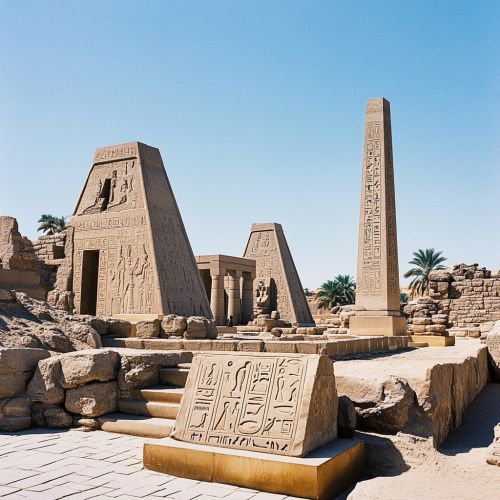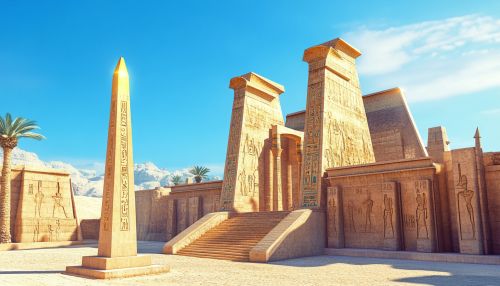Fifth Dynasty of Egypt
Overview
The Fifth Dynasty of Egypt is a significant period in the history of Ancient Egypt, traditionally dated from approximately 2494 to 2345 BCE. This era is part of the Old Kingdom, which is often referred to as the "Age of the Pyramids" due to the extensive pyramid construction projects undertaken during this time. The Fifth Dynasty is notable for its religious developments, artistic achievements, and administrative innovations. It marked a transition in the political and religious landscape, with a growing emphasis on the solar cult of Ra (Egyptian God).
Historical Context
The Fifth Dynasty followed the Fourth Dynasty and preceded the Sixth Dynasty, continuing the tradition of centralized power and monumental architecture. This period saw a shift in the political power structure, with the pharaohs increasingly relying on a bureaucratic administration. The dynasty is believed to have been founded by Userkaf, who established a new royal lineage possibly through marriage alliances with the previous dynasty.
Political Developments
The Fifth Dynasty was characterized by a more decentralized administration compared to its predecessors. The pharaohs delegated authority to viziers and other officials, which allowed for more efficient governance but also led to the rise of powerful provincial governors. This decentralization is reflected in the increased prominence of non-royal tombs and inscriptions, indicating the growing influence of the nobility.
Religious Changes
A significant religious development during the Fifth Dynasty was the elevation of the sun god Ra to a preeminent position in the Egyptian pantheon. This shift is evident in the construction of sun temples, particularly the temple of Abu Gorab Sun Temple, dedicated to Ra. The pharaohs of this dynasty were often referred to as "Sons of Ra," highlighting their divine connection to the sun god. This period also saw the introduction of the Pyramid Texts, the earliest known religious texts inscribed in the pyramids of the later kings of the dynasty.


Art and Architecture
The Fifth Dynasty is renowned for its artistic and architectural achievements. While the construction of massive pyramids continued, there was a noticeable shift towards smaller, more refined structures. The pyramids of this era, such as those at Saqqara Necropolis, were often accompanied by elaborate mortuary temples and sun temples.
Pyramid Construction
The pyramids of the Fifth Dynasty were generally smaller than those of the Fourth Dynasty, reflecting changes in religious and political priorities. These structures were often built with a core of rubble and a casing of finer limestone, which has not survived as well as the solid stone constructions of earlier dynasties. Notable pyramids from this period include those of Userkaf, Sahure, and Neferirkare Kakai.
Sun Temples
The construction of sun temples was a distinctive feature of the Fifth Dynasty. These temples were dedicated to the worship of Ra and featured open courtyards, obelisks, and altars. The most famous sun temple is that of Niuserre at Abu Gorab, which exemplifies the architectural style of the period with its emphasis on solar worship.
Artistic Innovations
Artistic expression during the Fifth Dynasty reflected the religious and political changes of the time. There was an increased use of relief sculpture and painted decoration in tombs and temples. These artworks often depicted scenes of daily life, religious rituals, and the afterlife, providing valuable insights into the culture and beliefs of the period.
Economy and Society
The economy of the Fifth Dynasty was primarily based on agriculture, with the Nile River providing fertile land for crops. The administration organized large-scale agricultural projects, including irrigation systems and granaries, to support the growing population. Trade with neighboring regions, such as Nubia (Region) and the Levant, was also significant, bringing in valuable resources like gold, copper, and exotic goods.
Social Structure
The social hierarchy of the Fifth Dynasty was complex, with the pharaoh at the top, followed by a class of nobles and officials who managed the administration and religious institutions. Below them were skilled artisans, craftsmen, and laborers who contributed to the construction of pyramids and temples. The majority of the population were farmers and peasants who worked the land and supported the economy.
Trade and Foreign Relations
Trade was an essential aspect of the Fifth Dynasty's economy, with expeditions sent to distant lands to acquire resources and establish diplomatic relations. The pharaohs maintained trade routes with Byblos (Ancient City) and Land of Punt, importing cedar wood, incense, and other luxury items. These interactions facilitated cultural exchanges and the spread of Egyptian influence beyond its borders.
Notable Pharaohs
Several pharaohs of the Fifth Dynasty left a lasting impact on Egyptian history through their contributions to religion, architecture, and governance.
Userkaf
Userkaf is considered the founder of the Fifth Dynasty and is credited with establishing the tradition of sun temple construction. His reign marked the beginning of the dynasty's focus on solar worship and administrative reforms.
Sahure
Sahure is known for his military expeditions and trade missions, which expanded Egypt's influence and wealth. His pyramid complex at Abusir is notable for its artistic reliefs depicting naval expeditions and foreign tribute.
Neferirkare Kakai
Neferirkare Kakai's reign saw the continued development of the solar cult and the construction of the largest pyramid of the dynasty. His administration introduced new titles and offices, reflecting the growing complexity of the government.
Niuserre
Niuserre is remembered for his architectural achievements, particularly the construction of his sun temple at Abu Gorab. His reign is considered a period of stability and prosperity, with a focus on religious and artistic endeavors.
Decline and Transition
The decline of the Fifth Dynasty is attributed to several factors, including internal strife, economic challenges, and the increasing power of provincial governors. The weakening of central authority paved the way for the rise of the Sixth Dynasty, which continued many of the religious and administrative practices established by its predecessor.
Legacy
The Fifth Dynasty left a lasting legacy in Egyptian history, particularly in the areas of religion, art, and governance. The emphasis on solar worship and the construction of sun temples influenced subsequent dynasties and contributed to the development of the New Kingdom of Egypt. The administrative innovations and artistic achievements of this period set the stage for the continued evolution of Egyptian civilization.
